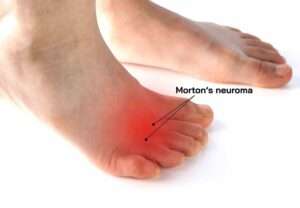Morton’s Neuroma
What is Morton’s Neuroma?
Morton’s Neuroma is a painful foot condition that feels like a hard, tender pebble between the toes—typically between the third and fourth toes. It occurs when the tissue surrounding one of the nerves in the foot becomes thickened, causing pressure on the nerve and surrounding structures, which results in pain.
An easy way to test if you may have a Morton’s Neuroma is to squeeze the sides of your foot. If this increases the pain, you may be dealing with a neuroma. While Morton’s Neuroma can be painful, the condition generally does not lead to any long-term issues once the inflammation and irritation are addressed. Through targeted treatments, significant relief can often be achieved.

Symptoms of Morton’s Neuroma
Symptoms of Morton’s Neuroma may include:
- A clicking feeling in the forefoot, followed by sharp, shooting pain.
- A sensation of numbness or pins and needles extending into the toes.
- Pain that worsens when wearing tight, narrow shoes or after prolonged periods of standing or walking.
The inflammation associated with Morton’s Neuroma can intensify with time, making symptoms more frequent and severe.
Identifying the Cause
The underlying cause of Morton’s Neuroma can vary between individuals. That’s why it’s important to have a comprehensive assessment to determine all contributing factors. This will help address the symptoms quickly and reduce the chances of the neuroma returning in the future.
Your podiatrist will conduct a biomechanical and gait analysis to identify whether poor foot alignment or function is contributing to your condition.
Treating Morton’s Neuroma
Treatment typically begins with the most conservative approach:
- Footwear adjustments: Wearing well-fitted shoes with a wide toe box that do not squeeze your feet or toes can make a significant difference.
- Pre-metatarsal pad or dome: This is designed to help lift and separate the bones in your foot, giving the nerve more space and relieving pressure.
- Custom orthotics: If your foot structure or mechanics are contributing to the condition, custom orthotics can help manage the symptoms by correcting alignment and providing cushioning.
- Steroid injections: In some cases, a local anaesthetic combined with a steroid injection can help reduce inflammation and alleviate acute symptoms. This, however, is generally considered a secondary treatment option.
Surgical Intervention
If conservative treatments fail and symptoms persist, surgery may be considered. The procedure typically involves cutting the affected nerve and removing the neuroma. This results in some numbness along the affected toes, and in rare cases, the nerve may form a Stump Neuroma, leading to further discomfort.
Expected Outcome
Approximately 75% of people experience significant symptom resolution with conservative treatments. Most individuals find relief through adjustments in footwear, orthotic devices, and other non-invasive therapies, avoiding the need for surgery.
If you’re experiencing symptoms of Morton’s Neuroma, don’t wait for the pain to worsen. Contact a podiatrist for a thorough evaluation and effective treatment plan to help you get back on your feet.
